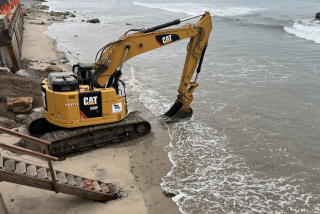Development on Malibu Beach Rejected Again
In a decision closely watched by environmentalists and property rights advocates, the California Coastal Commission has rejected for the second time in 13 months a developer’s plans to build luxury homes on a private Malibu beach.
The 8-3 vote last week to reject Norman Haynie’s plans to build up to 16 houses on pristine Lechuza Beach left opponents, including dozens of residents whose million-dollar views would have been affected, jubilant.
“We’re ecstatic,” said Tony Giordano, president of the Malibu Encinal Home Owners Assn. “A lot of people have worked very hard to preserve that beach and it paid off.”
An attorney for Haynie said that the developer will pursue the matter in the courts, and expressed confidence that his client will prevail.
“You don’t lose a fight when you’ve lost a round,” said Sherman Stacey, the attorney. Environmentalists had argued that approval of the project would have destroyed Lechuza Beach and set a devastating precedent for construction along the state’s coastline.
Opponents contend that to have allowed Haynie to build the homes on a 1,600-foot stretch of beach in western Malibu threatened to redefine “infill,” an arcane coastal policy that essentially restricts new development to one or two parcels at a time.
They argued that to allow a half-mile row of beach houses to be built as part of the same project would have triggered development along numerous other private beaches for the length of the state’s 1,100-mile coast.
Haynie accused residents of the private, gated community above the beach of wanting to keep Lechuza as their own domain without regard for his property rights.
The coastal panel rejected his plans in 1991. Last June, the Supreme Court ruled in favor of a South Carolina property owner in a case that Haynie contends is remarkably similar to his own. A Superior Court judge in November sided with Haynie and ordered the commission to reconsider the matter.
As it had done previously, the commission ruled that Haynie and his associates had no right to build on their own property because to do so would violate the state’s coastal protection law, which prohibits seawalls from being built except to protect existing structures.
State officials had said that the homes would be unsafe without a seawall.
Meanwhile, the State Lands Commission contended for the first time last week that part of the developer’s project is actually on state property.
Several commissioners said the claim by State Lands Commission Executive Officer Charles Warren in a letter read to the panel played a key role in their deliberations.
Opponents in the past have challenged the location of the mean high tide line as it relates to Haynie’s project. By law, all land seaward of that mark is public property.
The beach was last surveyed in 1932.
At the hearing, a surveyor hired by the Coastal Commission staff said tide changes and beach erosion have caused the mark to shift in such a way that it is now 38 to 67 feet onto property claimed by Haynie.
“Without question, the mean high tide line is located landward of the proposed improvements,” said Francois Uzes, the surveyor.
Stacey, the developer’s attorney, dismissed the state’s property claim as “cooked up.” He also labeled as an act of desperation the coastal staff’s contention that to approve the project would violate a 50-year-old law governing navigational easements.
Stacey said the Coastal Commission had approved 148 houses on sandy beaches in Malibu since 1982 and that only once had the State Lands Commission raised questions about the mean high tide line.
“If you applied to everyone the standard that is being applied to Mr. Haynie, chances are none of those homes would ever have been built,” he said.
Haynie bought the property in 1991 and contends that his being prevented from building the houses constitutes an unlawful taking without compensation, prohibited by the 5th Amendment to the U.S. Constitution.
The Supreme Court ruled last year in the South Carolina case that officials may prevent development without compensation if the land use would be a nuisance and cause clear harm to others, but they cannot refuse compensation simply because banning the development would benefit the public.
Stacey said that the lawsuit his client intends to file soon against the Coastal Commission will have “strong similarities” to that brought by David Lucas against the South Carolina Coastal Council.
Opponents said that while the South Carolina action may have rendered Lucas’ property worthless, Haynie has rejected a $2.1-million offer from residents who do not want to see the beach developed.
Through their attorney, Robert Philibosian, about two dozen residents of the bluffs above Lechuza Beach last week publicly renewed the offer, saying it would be good until the end of the month.
More to Read
Sign up for Essential California
The most important California stories and recommendations in your inbox every morning.
You may occasionally receive promotional content from the Los Angeles Times.










